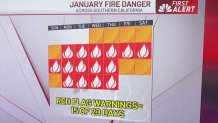A red flag warning has been extended through 10 a.m. on Friday as strong winds blow ash and dust into the air. This video was broadcast on the NBC4 News at 4 a.m. on Jan. 23, 2025.
What to Know
- A red flag warning remains in effect through Friday morning for parts of Los Angeles County.
- Red flag warnings have been issued in Southern California for 15 of the first 23 days of January.
- Included in some of the red flag warnings was a Particularly Dangerous Situation alert, indicating fire danger beyond that of a typical red flag warning.
- January includes consecutive red flag warning days from Jan. 6 through Jan. 16.
- The Palisades Fire and Eaton Fire, two of the deadliest and most destructive fires on record in California, started and rapidly spread in that 11-day window.
- The Palisades Fire on the LA County coast was 72-percent contained at 23,400 acres. The Eaton Fire in the Altadena area was 95-percent contained at 14,000 acres.
Firefighters are gaining ground on three major fires in Los Angeles County, where a red flag warning that went into effect earlier this week for parts of the region was extended into Friday.
So far in January, the high fire danger forecast is a recurring theme. There have been 15 days of red flag warnings in Los Angeles County through 23 days this month.

Get top local stories in Philly delivered to you every morning. Sign up for NBC Philadelphia's News Headlines newsletter.
That includes consecutives days of red flag warnings from Jan. 6 to Jan. 16 that offered little relief for firefighters who have battled the deadly Palisades and Eaton fires, the fast-moving Hughes Fire in Castaic and many other smaller fires that crews prevented from reaching structures and neighborhoods. The Palisades Fire started on the morning of Jan. 7 in Pacific Palisades followed hours later by the Eaton Fire in the Altadena area in a Santa Ana windstorm that firefighters described as among the worst they've seen.
"Today is another one," said NBC4 meteorologist Belen De Leon. "We have fire danger very present with the winds increasing as we go through the middle of the day."
Included in several red flag warning days was a Particularly Dangerous Situation alert, a National Weather Service alert that indicates elevated red flag conditions. The area was under a PDS alert Jan. 7 when winds around 80 mph whipped flames and threw embers from the Palisades and Eaton fires, which are among the deadliest and most destructive fires on record in California.
Twenty-eight deaths have been reported in the two fires with thousands of structures, including homes and businesses, destroyed.
This week's red flag warning, which went into effect Monday, is expected to expire at 10 a.m. Friday. Significantly cooler temperatures and a slight chance of rain are in the weekend forecast.
In addition to the powerful Santa Ana winds, another reason for the warnings is a lack of rainfall during what is usually the wettest time of year in Southern California.
The region is under severe drought conditions after a dry start to the wet season in Southern California. After two seasons of above-average rainfall, a months-long dry spell left hillsides covered in dry brush, providing fuel for wildfires.
Under a red flag warning, any fires that do start are more likely to spread at a rapid rate behind strong winds. Flying embers also speed a brush fire's spread. Powerful gusts can cast hot embers for miles, starting spot fires ahead of the main fire line in a nightmare scenario for firefighters.

